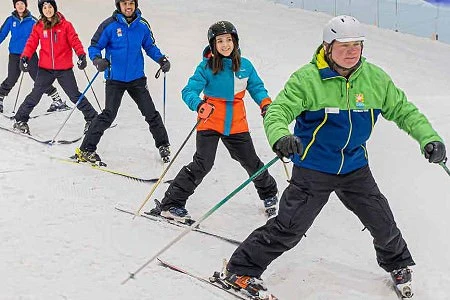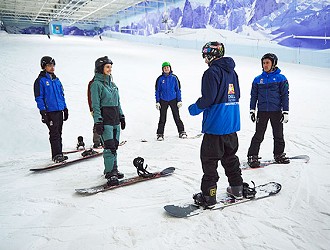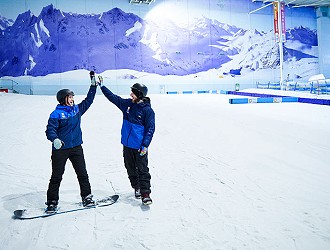How to Ski in Powder: Our Instructors' Top Tips for Skiing in Deep Snow

Whether you’re new to winter sports or have been an enthusiast for some time, it may be your dream to ski in powder. It requires a higher level of skill and technique, and the sensation of gliding through a blanket of untouched snow is like nothing else. But what exactly is powder skiing? And what are the best tips on how to ski in powder?
Powder skiing refers to fluffy, lighter snow and it is a stark difference to the sensation of skiing on groomed trails of hard-packed snow. So if you’re looking to master the art of powder skiing, you’re in the right place. Our expert instructors here at Chill Factore have shared their top tips on how to ski in powder so you’ll be skiing in style and confidence before you know it!
How to ski in powder - our top tips
Get the right equipment
When it comes to learning how to ski in powder, it isn’t just different techniques and skills you need to have to succeed, you also need the right equipment. For example, by having wider skis than you’d usually use you can enjoy better flotation that makes it easier to stay on top of the snow instead of sinking in it. This is important if you want to master the art of powder skiing.
Similarly, you should also have adjustable poles so that you can adjust your pole plants for variable conditions. By choosing poles with adjustable lengths, you can be more versatile and take on different deeper snow more easily.
We’d also recommend that you mix up your ski wear a bit too. High-quality goggles are always a must-have as snow can fly everywhere when skiing in powder conditions, so having good goggles suited for low-light conditions will improve your visibility. Lightwear gear can also make a big difference when maneuvering through deep snow making quick and nimble movements easier.
Master the right stance
Mastering the right stance is the make or break of perfecting powdering skiing, and many skiers make the same common mistake. While your initial reaction may be to sit back when skiing in powder, the powder adds extra resistance to the snow which can make you feel the need to sit back to be centered.
But instead, you should maintain a neutral stance with your shoulders over your knees. This will make it easier for you to maintain your flexibility and balance. A neutral stance will also allow your lower joints to be more mobile so you can adjust as the conditions change.
Keep your momentum
One of the biggest challenges you’ll face when learning how to ski in powder is the change of speed from what you’re used to. As powder is deeper it can slow you down and you may find yourself stuck.
Let’s check out some of our expert’s top tips to prevent this:
- Start on a steeper slope - if you’re new to powder and are still getting your head around how to ski in deep snow then we’d recommend that you start off choosing a steeper slope than you’d normally ski on. Adding a gradient is a great way to help maintain your speed and prevent you from getting stuck.
- Stay active - keeping your momentum is so important when powder skiing so we’d recommend that you keep your movements continuous. Don’t wait for the dust (or snow!) to settle. Instead, as soon as you come out of a turn, start initiating the next one.
Read (and react) to the terrain
Another top tip to help you learn how to ski in powder is to read the terrain and keep a lookout for changes in the terrain. In deeper snow things may be more difficult to notice, but subtle shifts in the snow’s appearance could suggest that there are changes in consistency or depth that you need to be aware of.
While skiing on a fresh dump of snow can feel amazing, don’t forget that a flatter terrain makes it easier for you to go faster and build up your momentum. But remember that the powder can cause extra resistance and slow you down, so we’d recommend adjusting your turns by letting your skis stay in the fall line. This will make it easier to keep that momentum.
Practice, practice, and then practice some more
Of course, just like when learning any new skill you must give yourself plenty of time to practice. So whether you’re heading off on a skiing trip soon or you ski regularly at home, Chill Factore is the perfect place to perfect new techniques and learn how to ski in deep snow.
There are a range of different skiing lessons available for every type of skier. These include beginner ski lessons, kid’s ski lessons and more advanced adult ski lessons for those who want to develop new techniques - such as learning how to ski in powder. Think you’d benefit more from some one-on-one lessons, you can also have ski private lessons with our Chill Factore experts. With our team on hand, you’ll be embracing powder skiing with confidence before you know it.
For more information on the lessons and services we provide, contact us today.













